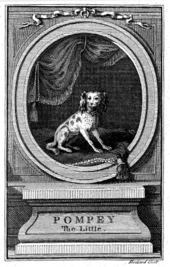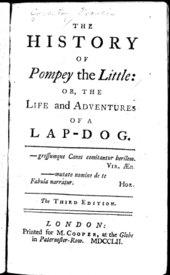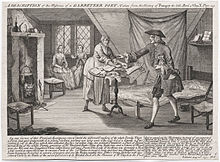The History of Pompey the Little; or, The Life and Adventures of a Lap Dog

The History of Pompey the Little; or, The Life and Adventures of a Lap-Dog is a satirical novel by the English writer Francis Coventry , first published in 1751 . In it, Coventry caricatured the English society of its era from the perspective of a lap dog .
content
The title hero, Pompey, a miniature spaniel , was born as the son of Julio and Phyllis in Bologna in 1735, "a place famous for lap-dogs and sausages", that is, a place that was famous for lap dogs and sausages among his contemporaries. At an early age, Pompey was kidnapped from his original home, the boudoir of an Italian lady, by Hillario, pretending to need the dog as a reminder of their mutual love. Hillario, an English gentleman notorious for his gallant adventures, eventually brings the dog to London . There he uses its cuteness to attract the attention of the noble ladies and tells them a tearful story about how he got to the dog.
The rest of the story is a downright chain of social episodes, with each episode ending with an event that makes Pompey the property of a new personality. As a result, the reader finds himself involved in dozens of consecutive scenes that always contrast strongly with the previous ones. Francis Coventry only tells as much as the reader needs to know in order not to lose his attention, and makes the transition from scene to scene more plausible.
Publication history and reception
At Magdalen College , Cambridge , where he studied from 1746, Coventry met the poet Thomas Gray and presented him with a comedy that had not survived that was to provide the basis for Pompey the Little . Coventry wrote much of the later work in Cambridge .
The work saw three editions during Coventry's lifetime and was popular with the public. By 1800 there were already eight authorized editions and two illegal “pirate copies”. In an era in which, from today's point of view, comparatively small (first) editions were created for an equally small potential readership and high publication costs made books a luxury item, as long as it was not printed as pirated paperback as in Amsterdam , Pompey the Little was extraordinary successfully:
" The discovery of the authorship made Coventry a nine-days' hero, while his book went into a multitude of editions. It was one of the most successful 'jeux d'esprit' of the eighteenth century . "
The editions differed quite clearly from each other, as the later editors to a certain extent released the names of the fine ladies and gentlemen, which were still encrypted at Coventry, or changed the titles of the chapters. The first changes in the 5th edition of 1773 were so complex that the first reviewers refrained from listing them in detail. Since Lady Montagu had already pointed out during Coventry's lifetime that the descriptions of Lady Tempest and Lady Sophister from Chapter 4 portrayed herself and Lady Oxford, it was subsequently assumed that behind every character described there was a real historical personality would.
The novel is a product of a transitional period in the development of the novel, when this literary genre was viewed as the high point of fashionable art development, but also individualized novels, despite the simultaneous great successes, the works of Samuel Richardson ( Pamela , 1740; Clarissa , 1748/49), Henry Fieldings ( Joseph Andrew , 1742; Tom Jones , 1749), Sarah Fielding ( The Adventures of David Simple , 1744), Tobias Smollet ( Roderick Random , 1748; Peregrine Pickle , 1751), Lawrence Sterne ( Life and Opinions of Tristram Shandy Gentleman , 1759/67) or Charlotte Lennox ( The Female Quixote , 1751) in the middle of the 18th century, in which misunderstanding of the later development was regarded as a passing fad. In the second half of the eighteenth century “the flood of novel prose swells incessantly until it becomes so raging that the mind of the individual can no longer cope with it. Already at the end of the 18th century the development was all too varied to be described easily. "
In England, Pompey was not reprinted again until 1926 after the 1824 edition.
Johann Friedrich Jünger also translated this successful English title from the mid-1750s over 30 years later under the title The Little Caesar for the first time directly into German . There is an earlier German version, but it was based on a French translation of the original by François-Vincent Toussaint from 1752 , which had already been edited . In his foreword, Jünger was condescending to this approach, but admitted that his work was more of a revision than a translation. This is already noticeable in his choice of title, because a more correct eponymous name would have been that of Gnaeus Pompeius the Younger , which, however, apparently could not prevail against that of Gaius Julius Caesar because of its lower popularity . This translation already differed in title from all other European translations.
Interpretation and classification
Francis Coventry makes use of the apparently objective nature of the dog in his novel to hold the mirror up to society. At the same time he caricatures, by already at the beginning of his book, the nature of his hero to a certain extent higher ethical dispositions than those of humans, the zeitgeist attitude that manifested itself in the 18th century, that the dog as a companion, as the "most loyal companion" or even "better People “unreflectively inflated.
“And can we, without the basest ingratitude, think ill of an animal, that has ever honored mankind with his company and friendship, from the beginning of the world to the present moment? While all other creatures are in a state of enmity with us (...) Nor do they trouble us only with officious fidelity, and useless good-will, but take care to earn their livelihood by many meritorious services: they guard our houses, supply our tables with provision, amuse our leisure hours, and discover plots to the government. Nay, I have heard of a dog's making a syllogism; which cannot fail to endear him to our two famous universities, where his brother-logicians are so honored and distinguished for their skill in that useful science. "
As a literary genre, according to Burkhard Meyer-Sickendick, the book can be assigned to the “mock-heroic epic”. This genre, which initially served primarily affect poetics , begins long after the pseudo-Homeric " Batrachomyomachia ", a mocking heroic epic parody in which animals (or objects) are given human characteristics. The first examples in Europe are Alessandro Tassoni's La secchia rapita (1622), the related epic Le lutrin (1674) by Nicolas Boileau , and in England with the satirical verses The Rape of the Lock (1714) or The Dunciad (1728) by Alexander Pope and the prose satire The Ballad of the Books (1704) by Jonathan Swift . The History of Pompey the little transfers the stylistic devices to the novel for the first time. Thereafter, there were also various German-language adaptations of these remedies in the second half of the 18th century, for example by JFW Zachariae ( Der Renommiste , 1744), Johann Peter Uz ( Der Sieg des Liebesgottes , 1753) and Joseph Franz Ratschky ( Melchior Striegel , 1799).
“In contrast to the pseudohomeric work, which mocks the classic epic and its heroes by relocating the great battles of the Greek saga to the animal kingdom, the comic effect of the mock-heroic epic (...) arises from the fact that the Homeric formal elements on a low object can be transferred from the contemporary present. So you don't laugh at strange animals, but at the irony of contemporary society (...). "
expenditure
- The History of Pompey the Little, or the Life and Adventures of a Lap-Dog. Mary Cooper, London 1751 ( archive.org ).
- Robert Adams Day (Ed.): The history of Pompey the Little: or, The life and adventures of a lap-dog. Oxford University Press, London / New York 1974.
- German translation: Johann Friedrich Jünger: The little Caesar. After the English of Coventry. Dykische Buchhandlung, Leipzig 1782 ( books.google.de ).
- The History of Pompey the Little. Cooke's Edition 1799 ( books.google.de ).
Web links
- The History of Pompey the Little, or the Life and Adventures of a Lap-Dog. Full text of the 3rd edition 1752.
- Podcast on Librivox
Individual evidence
- ↑ a b Pompey the Little . Book 1, Chapter I, 2nd edition. 1752 . Accessed November 2, 2012.
- ↑ a b Pompey the Little . Book 1, Chapter IV, 2nd edition. 1752 . Accessed November 4, 2012: “The poor, dear, tender woman died, I hear, within three weeks after my departure; but this dog, this divine little dog, will I keep everlastingly for her sake. "
- ^ A b c Edmund Gosse : Gossip in a library. 1913. On: www.gutenberg.org . Accessed November 2, 2012.
- ↑ a b c d e Gale Cengage: Francis Coventry . In: Literary Criticism (1400-1800). Vol. 46. Dale, Detroit 1999. ( Page no longer available , search in web archives ) Info: The link was automatically marked as defective. Please check the link according to the instructions and then remove this notice. On: www.enotes.com. Accessed October 31, 2012.
- ^ A b Alan Hager (Ed.): Encyclopedia of British Writers. Facts on File, New York 2005, p. 71.
- ↑ See: The bibliographer's manual of English literature containing an account of rare, curious, and useful books, published in or relating to Great Britain and Ireland, from the invention of printing; with bibliographical and critical notices, collations of the rarer articles, and the prices at which they have been sold in the present century. Edited by William Thomas Lowndes, W. Pickering London 1834, p. 1480.
- ^ Notes and Queries . November 6, 1852, p. 433.
- ^ "Sarah Fielding". Encyclopædia Britannica Online . Accessed October 31, 2012.
- ^ Arno Löffler : Lennox, Charlotte. In: Metzler Lexicon of English-Speaking Authors . 631 portraits - from the beginning to the present. Edited by Eberhard Kreutzer and Ansgar Nünning , Metzler, Stuttgart / Weimar 2002, ISBN 3-476-01746-X , p. 346.
- ↑ M. Battestin: Henry Fielding: A Life. Routledge, London 1993, p. 543.
- ^ Ifor Evans : History of English Literature. Translated from the English by Paul Baudisch . Revised from the 1976 edition by Manfred Vasold , Beck, Munich 1983, ISBN 3-406-09324-8 , p. 183.
- ↑ Frontipiz of the 1926 reprint . On: www.bridgemanart.com. Accessed November 3, 2012.
- ↑ Jeremy Black: Culture in Eighteenth-Century England: A Subject for Taste. Continuum International Publishing Group, London a. a. 2007, p. 55.
- ^ The history of Pompey the Little: or, The life and adventures of a lap-dog. Edited by Robert Adams Day, Oxford University Press, London / New York 1974. Introduction, p. XXI.
- ↑ a b Burkhard Meyer-Sickendick: Affektpoetik: A cultural history of literary emotions. Königshausen & Neumann, Würzburg 2005, p. 419.
- ^ The Rape of the Lock. Opera . On: debmasonstudio.com. Accessed November 3, 2012.
- ^ The Rape of the Look. Summary and comments. On: Sparknotes.com. Accessed November 3, 2012.
- ^ William S. Anderson: The Mock-Heroic Mode in Roman Satire and Alexander Pope. In: Satire in the 18th Century. Edited by JD Browning, New York 1983, pp. 198-213.
- ↑ See Martin Blocksidge: The sacred weapon. An Introduction to Pope's Satire. Lewes 1993.

